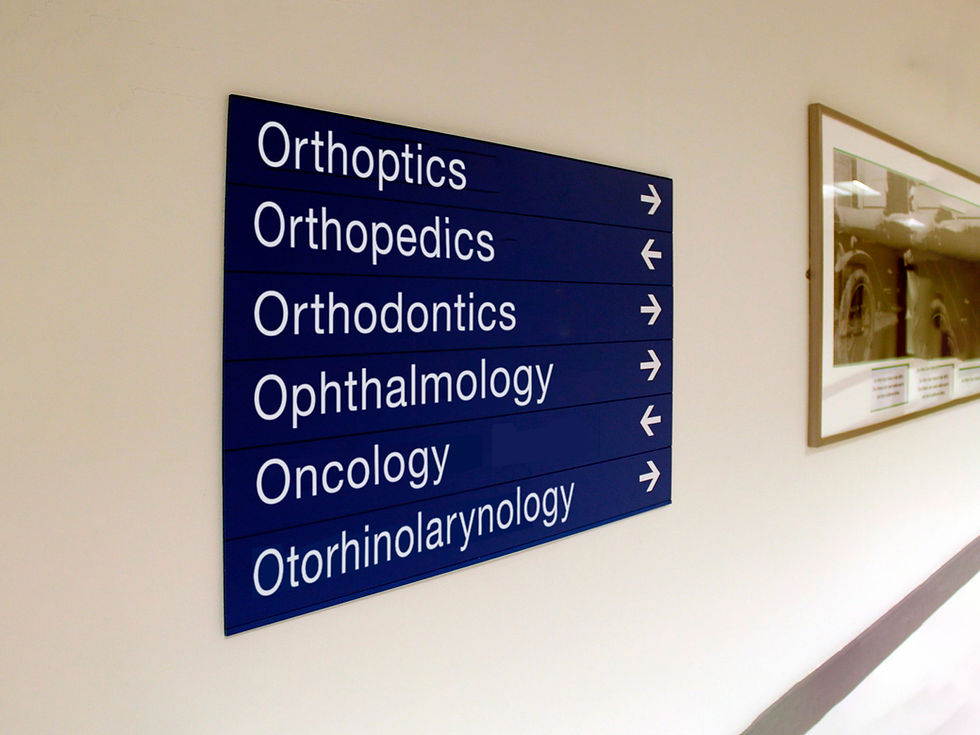Better Healthcare Wayfinding through Clarity and Consistency
- Marc Jenkins
- Sep 11
- 3 min read
Updated: Sep 13

The modern hospital is under enormous pressure to improve patient experiences. Inefficiencies in patient flow and late and missed appointments burden already stretched staff, taking precious time from their jobs and only adding further inefficiencies to the system. A study from a UK Hospital with approximately 300 beds showed that an annual total of 4,500 staff hours were spent guiding patients and relatives who needed directions.
Over time, hospitals have become larger and more complex with multiple services spread across numerous floors and buildings, meaning patients, staff and equipment are in a constant state of movement. Without effective means to guide people and locate critical resources, patients are left feeling anxious, confused and irritated, hindering the hospital’s ability to deliver critical care.
Visitors often face confusing corridors and complex terms that hinder navigation and understanding. Often, wayfinding consultants recommend clear, user-friendly language—using words like “kidney” instead of “renal” or “blood test” instead of “phlebotomy.” Others, myself included, err towards using a generic, functional address system (like “Ward” or “Department”) with names disconnected from activities to help users find destinations without understanding medical details. But is such abstraction necessary? Could stripping away all clinical terms reduce stress, or do names reinforce expectations of treatment and professionalism?
Naming is crucial for successful wayfinding, providing structure and simplicity, but inconsistencies in naming systems often create confusion—the naming of places is frequently overlooked or managed carelessly.
Clarity and consistency must extend to signs, informational materials, and staff language. For example, in a large hospital, the X-ray department was difficult to locate despite prominent signage, as consultants referred to it as “Radiology,” while the signs read “X-ray.” The solution was not more signage, but standardising terminology among staff and signage.
Names should be both functional and easy to understand. One project highlighted elderly users looking for the Dental Department but ending up in the Sexual Health Clinic because “GUM” (Genito-Urinary Medicine) sounded dental-related, while “Orthodontic Department” was not recognised as dentistry.
While simplification aids navigation and reflects the reality that over a third of UK adults have low health literacy, medical terminology can still reassure or inform some users. The central question is: How far should we take simplification? Is it enough to rename the “Geriatric Ward” as “Elderly Care,” or should we remove all specific references without compromising user perception or wayfinding effectiveness?
A straightforward, low-key system using sequential numbers enables users to easily follow directions, locate buildings, and find destinations within them. It doesn’t require additional navigation gadgets and is actually more comprehensive, as it can map all routes through a building, not just to major destinations.

At AZ Groeninge in Belgium, Humanics Collective introduced a sequential numbering system to replace complicated department names. Each area was assigned a letter (e.g., B, C, D, E), and destination numbers were grouped into manageable blocks (e.g., B020–B029). These numbers appeared on appointment tickets printed at check-in kiosks and synced with digital information systems.
This approach also addressed a unique Belgian challenge: language. In Flanders, public signage must legally be in Dutch, but AZ Groeninge serves both Dutch and French-speaking communities. By replacing long, Latin-based department names with short alphanumeric codes, the hospital created a legally compliant and instantly accessible wayfinding system, regardless of the visitor’s first language.
The result is a system that adapts to cultural, linguistic, and operational requirements without sacrificing usability.
Studio Marc is an Associate Partner of Humanics Collective

